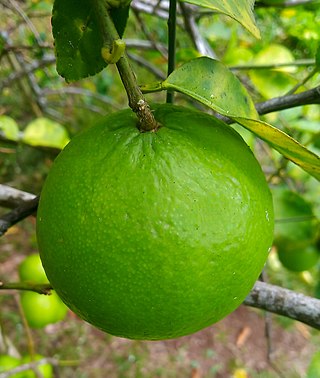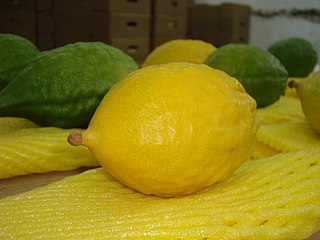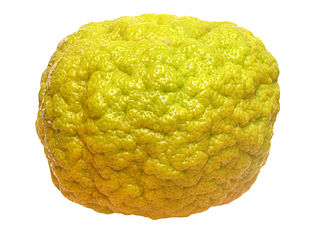
Citrus is a genus of flowering trees and shrubs in the rue family, Rutaceae. Plants in the genus produce citrus fruits, including important crops such as oranges, lemons, grapefruits, pomelos, and limes. The genus Citrus is native to South Asia, East Asia, Southeast Asia, Melanesia, and Australia. Various citrus species have been used and domesticated by indigenous cultures in these areas since ancient times. From there its cultivation spread into Micronesia and Polynesia by the Austronesian expansion ; and to the Middle East and the Mediterranean via the incense trade route, and onwards to Europe and the Americas.

The mandarin orange, also known as mandarin or mandarine, is a small, rounded citrus tree fruit. Treated as a distinct species of orange, it is usually eaten plain or in fruit salads. Tangerines are a group of orange-coloured citrus fruit consisting of hybrids of mandarin orange with some pomelo contribution.

Etrog is the yellow citron or Citrus medica used by Jews during the week-long holiday of Sukkot as one of the four species. Together with the lulav, hadass, and aravah, the etrog is taken in hand and held or waved during specific portions of the holiday prayers. Special care is often given to selecting an etrog for the performance of the Sukkot holiday rituals.

The citron, historically cedrate, is a large fragrant citrus fruit with a thick rind. It is said to resemble a 'huge, rough lemon'. It is one of the original citrus fruits from which all other citrus types developed through natural hybrid speciation or artificial hybridization. Though citron cultivars take on a wide variety of physical forms, they are all closely related genetically. It is used in Asian and Mediterranean cuisine, traditional medicines, perfume, and religious rituals and offerings. Hybrids of citrons with other citrus are commercially more prominent, notably lemons and many limes.

The pomelo, from the family Rutaceae, is the largest citrus fruit, and the principal ancestor of the grapefruit. It is a natural, non-hybrid, citrus fruit, native to Southeast Asia. Similar in taste to a sweet grapefruit, the pomelo is commonly consumed and used for festive occasions throughout Southeast Asia and East Asia. As with the grapefruit, phytochemicals in the pomelo have the potential for drug interactions.

The Key lime or acid lime is a citrus hybrid native to tropical Southeast Asia. It has a spherical fruit, 2.5–5 centimetres in diameter. The Key lime is usually picked while it is still green, but it becomes yellow when ripe.

Citrus medica var. sarcodactylis, or the fingered citron, is an unusually-shaped citron variety whose fruit is segmented into finger-like sections, resembling those seen on representations of the Buddha. It is called Buddha's hand in many languages including English, Chinese, Japanese, Korean, Vietnamese, and French.

+ Laburnocytisus 'Adamii' is a horticultural curiosity; a small tree which is a graft-chimaera between two species, a laburnum, Laburnum anagyroides, and a broom, Chamaecytisus purpureus, which bears some shoots typical of the one species, some of the other, and some which are a peculiar mixture of both "parents". The plus sign (+) indicates the generic name is made for a graft-chimaera. The plant can also be described by the formula Laburnum anagyroides + Chamaecytisus purpureus.

Sweet lemon and sweet lime refer to groups of citrus hybrids that contain low acid pulp and juice. They are hybrids often similar to non-sweet lemons or limes, but with less citron parentage. Sweet limes and lemons are not sharply separated:
The sweet lime, Citrus limettioides Tan., is often confused with the sweet lemon, C. limetta Tan., which, in certain areas, is referred to as "sweet lime". In some of the literature, it is impossible to tell which fruit is under discussion.

The Greek citron variety of Citrus medica was botanically classified by Adolf Engler as the "variety etrog". This refers to its major use for the Jewish ritual etrog during Sukkot.

The Diamante citron is a variety of citron named after the town of Diamante, located in the province of Cosenza, Calabria, on the south-western coast of Italy, which is its most known cultivation point. This is why this variety is sometimes called the "Calabria Esrog". "Esrog" is the Ashkenazi Hebrew name for citron.

Grafting or graftage is a horticultural technique whereby tissues of plants are joined so as to continue their growth together. The upper part of the combined plant is called the scion while the lower part is called the rootstock. The success of this joining requires that the vascular tissues grow together. The natural equivalent of this process is inosculation. The technique is most commonly used in asexual propagation of commercially grown plants for the horticultural and agricultural trades. The scion is typically joined to the rootstock at the soil line; however, top work grafting may occur far above this line, leaving an understock consisting of the lower part of the trunk and the root system.

The Florentine citron – citron hybrid of Florence – is a very fragrant citrus fruit, which is named after its most known origin of cultivation. Its scientific name is Citrus × limonimedica 'Florentina' Lush.

Succade is the candied peel of any of the citrus species, especially from the citron or Citrus medica which is distinct with its extra-thick peel; in addition, the taste of the inner rind of the citron is less bitter than those of the other citrus. However, the term is also occasionally applied to the peel, root, or even entire fruit or vegetable like parsley, fennel and cucurbita which have a bitter taste and are boiled with sugar to get a special "sweet and sour" outcome.

The Yemenite citron is a variety of citron, usually containing no juice vesicles in its fruit's segments. The bearing tree and the mature fruit's size are somewhat larger than the trees and fruit of other varieties of citron.

The lemon is a species of small evergreen tree in the flowering plant family Rutaceae, native to Asia, primarily Northeast India (Assam), Northern Myanmar, and China.

Rhobs al-Arsa is a very popular citrus fruit in Morocco.

Citrus taxonomy refers to the botanical classification of the species, varieties, cultivars, and graft hybrids within the genus Citrus and related genera, found in cultivation and in the wild.

Pompia, also called pumpia, sa pompia, spompia, and China citron, is a Citrus hybrid cultivated for its edible fruit. It is a taxonomical synonym of Citrus medica.
Citrus medica × aurantium may refer to one of several hybrids between a citron and sour orange:




















